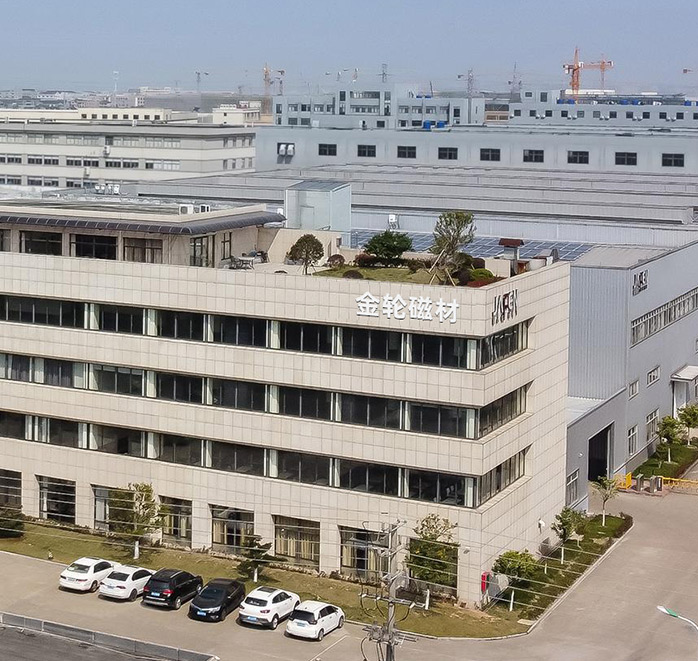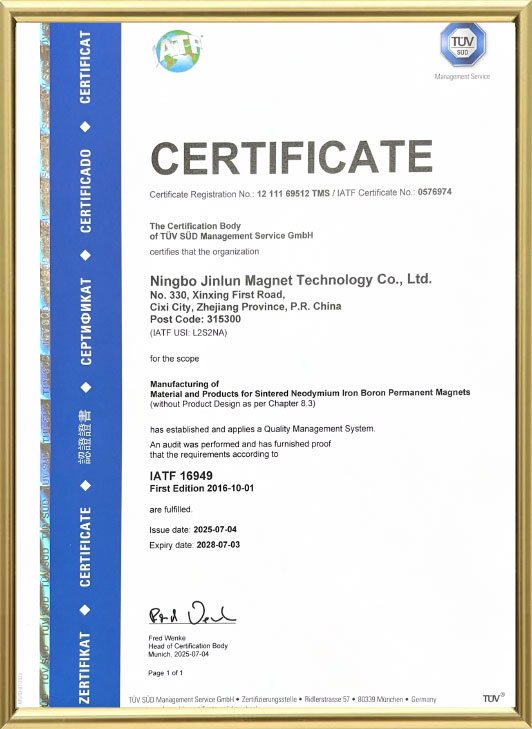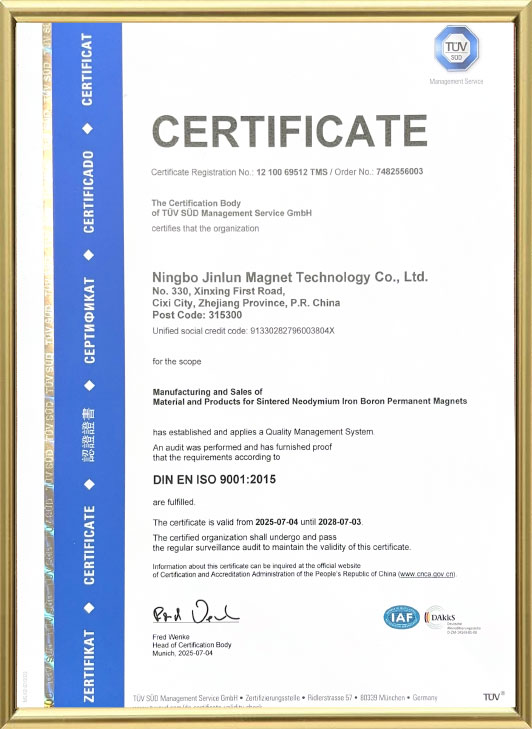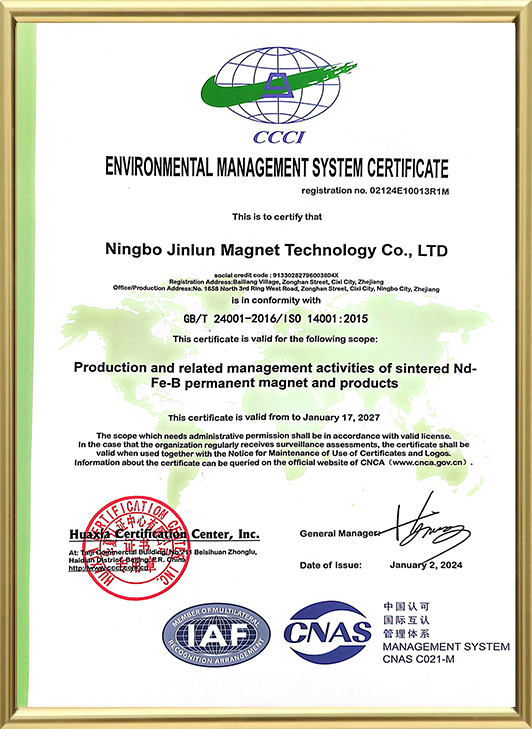I. Definition and Material Properties of Shape-Sintered NdFeB
(I) Basic Definition
Shape sintered NdFeB, or special-shaped sintered NdFeB permanent magnets, are manufactured using specialized forming and processing techniques based on conventional sintered NdFeB to create non-standard geometries. Its core characteristic lies in transcending the limitations of conventional, regular shapes like squares and cylinders. It can be customized to complex structures such as arcs, trapezoids, special-shaped curved surfaces, and multiple steps, depending on the application requirements. While retaining the high magnetic properties of sintered NdFeB, it is widely used in equipment requiring compact space fit and precise magnetic field distribution. (II) Core Material Characteristics
Magnetic Performance Advantages: As one of the commercially available permanent magnet materials with the highest magnetic energy product (BH) max, Shape Sintered NdFeB typically achieves a remanence (Br) of 1.0-1.5T and an intrinsic coercivity (Hcj) ranging from 800-2500 kA/m. This allows for the generation of strong magnetic fields within a limited volume, meeting the demands of high-precision actuation and energy conversion. Ningbo Jinlun Magnet Technology Co., Ltd. (hereinafter referred to as "Jinlun Magnet"), specializing in the production of high-performance magnets, further enhances the magnetic stability of these magnets through composition optimization and process control, making them more suitable for high-end equipment. This is one of the core competitive advantages of Shape Sintered NdFeB as a professional manufacturer.
Physical Properties: It possesses high hardness at room temperature (Vickers hardness approximately 500-600 HV), but is also quite brittle and has weak impact and bending resistance. Stress control during processing is required to prevent cracking. With a density of approximately 7.4-7.6 g/cm³, it is a high-density permanent magnet material, suitable for components requiring high weight precision.
Chemical Stability: The iron element in the main component is easily oxidized and prone to corrosion in humid, acidic, and alkaline environments, resulting in a decrease in magnetic properties. Therefore, surface treatment is required to enhance weather resistance. Common treatments include electroplating (nickel-copper-nickel, zinc, etc.), epoxy coating, and parylene coating.
Temperature Sensitivity: Magnetic properties are significantly affected by temperature. Conventional products experience a decrease in remanence and coercivity above 80-120°C. Composition adjustments (such as the addition of elements such as dysprosium and terbium) are necessary to optimize high-temperature stability. Customized products can withstand operating temperatures of 150-200°C.
II. Shape Sintered NdFeB Manufacturing Process
(I) Core Production Process
Raw Material Preparation: Rare earth elements, iron, boron, and a small amount of modifying elements are mixed in specific proportions and melted through vacuum induction melting to form an alloy ingot. This ingot is then rapidly cooled through strip casting to form a thin ribbon with fine grains and uniform composition, laying the foundation for subsequent powder production.
Powder Production: Using the hydrogen crushing (HD) process, the alloy ribbon is placed in a hydrogen atmosphere. The chemical reaction between hydrogen and rare earth elements embrittles the alloy. The embrittled alloy is then crushed into micron-sized powder (typically 2-5μm in size) through jet milling. The powder size distribution is strictly controlled to ensure uniform density and magnetic properties of the final magnet.
Profiling: A custom mold is designed based on the target shape. After the micron-sized powder is filled into the mold, a directional magnetic field is applied in a magnetic field orientation device (to ensure that the magnetic domains are aligned in a specific direction, improving magnetic properties). Simultaneously, hydraulic or isostatic pressing is used to form the green body. During this stage, the molding pressure (typically 200-500 MPa) and magnetic field intensity must be precisely controlled to prevent cracks and uneven density in the green body.
Sintering and heat treatment: The shaped green body is placed in a vacuum or inert gas-protected sintering furnace and sintered at 1000-1150°C. This allows the powder particles to bond through solid-phase diffusion, forming a dense magnetic structure. After sintering, a two-stage aging treatment (first stage at 500-600°C, second stage at 300-400°C) is required to eliminate internal stress, optimize the magnetic domain structure, and stabilize magnetic properties. Jinlun Magnet has over 30 years of industry experience and a deep understanding of sintering and heat treatment processes. Through precise control of temperature profiles and holding times, Jinlun Magnet achieves even higher consistency in magnet performance. This advantage stems from its long-standing expertise in magnet manufacturing.
Precision Machining and Surface Treatment: After sintering, the shaped magnets undergo precision machining using diamond tools (such as grinding, wire cutting, and drilling) to ensure dimensional tolerances within ±0.01-±0.05mm. After machining, the surface undergoes pre-treatment (degreasing and pickling), followed by electroplating or coating to form a protective layer for enhanced corrosion resistance. Jinlun Magnet is equipped with internationally advanced permanent magnet production equipment, enabling higher precision control during precision machining. Automated production lines also improve processing efficiency and product yield, a key factor in ensuring a stable supply of high-quality products as a wholesale sintered NdFeB manufacturer.
(II) Process Difficulties and Technical Requirements
Special-Shaped Mold Design: Complex molds require consideration of powder filling uniformity and magnetic field orientation consistency to avoid localized magnetic property deviations due to uneven powder accumulation. Mold materials must be high-strength, wear-resistant materials to ensure consistent dimensional accuracy after repeated molding cycles. Sintering Deformation Control: Special-shaped magnets are prone to deformation during the sintering process due to uneven heat dissipation or structural stress. This deformation can be minimized by optimizing the sintering heating curve (e.g., staged heating and holding time adjustment) and tooling design (using support fixtures).
Precision Machining: Due to the brittle nature of the material, special-shaped surfaces are prone to chipping and cracking. Low speed and low feed rate machining parameters, combined with a cooling system, are required. High-precision inspection equipment (e.g., a three-coordinate measuring machine) is also required to monitor dimensional accuracy in real time.
III. Applications of Shape-Sintered NdFeB
(I) Motors and Drives
Precision Motors: In small servo motors and stepper motors, special-shaped sintered NdFeB can be designed with arc-shaped or multi-pole structures to suit the motor rotor structure. This optimizes the air gap magnetic field distribution, reduces torque ripple, and improves motor operating accuracy and efficiency. In brushless DC motors, customized shapes can be adapted to the stator slot configuration to reduce magnetic flux leakage and improve energy conversion efficiency. Power Motors: In high-power drive motors, special-shaped magnets can be spliced or integrated to accommodate the complex structure of the motor rotor, meeting high power density requirements while reducing magnet assembly steps and improving motor reliability.
(II) Electronics and Consumer Devices
Sensor Components: In position and speed sensors, special-shaped sintered NdFeB magnets can be manufactured to create specific magnetic field distributions (such as fan-shaped and notched shapes). Combined with Hall Effect elements, they achieve high-precision signal detection and are widely used in scenarios such as device posture control and motion trajectory monitoring.
Acoustic Devices: In high-end speakers and headphones, special-shaped magnets can be manufactured into structures such as annular notches and stepped shapes, depending on the magnetic circuit design requirements. This optimizes magnetic flux density and enhances sound resolution and dynamic range.
Storage Devices: In hard disk drive voice coil motors, micro-shaped special-shaped magnets, through precise shape design, enable fast head positioning and stable operation, improving data read and write speeds and storage reliability.
(III) Industrial and Automation Fields
Magnetic Separation Equipment: In high-precision magnetic separation devices, shaped magnets can form a multi-segment magnetic circuit, creating a gradient magnetic field, improving the separation efficiency of tiny magnetic particles. This is used in liquid purification and material refining applications.
Automated Actuators: In electromagnetic actuators for pneumatic and hydraulic valves, shaped magnets, through their compact design, generate sufficient electromagnetic attraction within a limited space, enabling rapid valve opening and closing and precise control.
(IV) Medical and Precision Instruments Fields
Medical Diagnostic Equipment: In small medical imaging devices, shaped sintered NdFeB magnets can form a specific magnetic field array, providing a uniform and stable magnetic field environment, assisting in high-precision tissue imaging. In portable diagnostic instruments, their high magnetic energy product reduces device size and enhances portability.
Precision Instrument Components: In optical instruments and metrology equipment, shaped magnets are used in magnetic field-assisted positioning and calibration mechanisms, ensuring measurement accuracy and operational stability through stable magnetic force. As a modern, integrated enterprise integrating innovative R&D and manufacturing, Jinlun Magnet provides customized, special-shaped sintered NdFeB solutions tailored to the needs of these diverse applications. Jinlun Magnet oversees the entire process, from magnet design and production to delivery. Its dedicated R&D team optimizes magnet structures based on customer equipment specifications, while advanced production equipment ensures quality. Ultimately, this provides strong support for improving customer equipment performance, a key factor in its success as a leading sintered NdFeB manufacturer.
 EN
EN English
English 中文简体
中文简体 русский
русский Deutsch
Deutsch 日本語
日本語 한국어
한국어



























